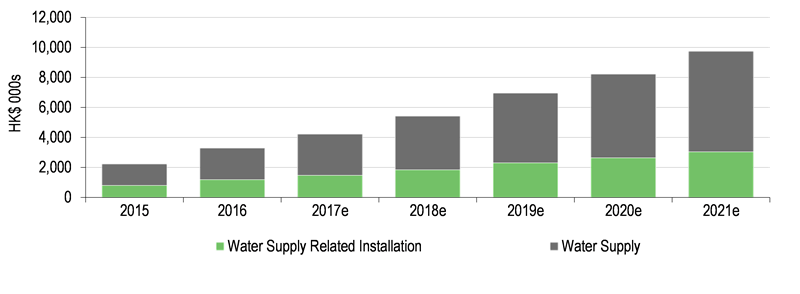CWA published its FY16 full year results in June. Key items to note were a headline revenue increase of 41% (20% once the IFRIC 12 accounting adoption is stripped out). The 20% underlying increase in full year revenues was mainly driven by high growth in the CWS segment. Installation revenues grew by 46% showing the company is continuing to connect a significant number of customers, which will, in turn, drive future revenues. We update our forecasts to reflect the stellar FY16 numbers although our revised five-year EBITDA CAGR is now slightly below our previous growth estimates (+19.8% versus +19.2%) due to the higher starting point. As demonstrated in the FY16 results, CWS is the main engine of growth. It provided 81% of group EBIT in FY16, growing by 46.9% year-on-year. Our five-year revenue CAGR of 22.8% for CWS is split between capacity growth, volume growth and tariff increases.
Financials: Upgrades across the horizon
Our updated five-year forward 21.5% revenue CAGR drives a 19.8% EBITDA CAGR over the same period. Contributing 81% of FY16 EBIT and, according to our forecasts, growing at a top-line CAGR of 24.2% for FY17-21e, the City Water Supply (CWS) unit is the main driver of CWA’s exceptional revenue expansion. High growth in CWS is, in turn, being driven by capacity growth predominantly, with positive contributions from tariff and volume increases. Capacity increases achieved by privatising formerly state-owned water supply networks will require significant capital expenditure in the years ahead. However, CWA’s strong operating cash generation and conservative balance sheet mean the company has room to invest without stretching key credit metrics; we forecast net debt to EBITDA will peak at 2.6x in FY17e.
Exhibit 5: CWA forecast change table
|
EPS* (c) |
PBT* (HK$m) |
EBITDA (HK$m) |
|
Old |
New |
% chg. |
Old |
New |
% chg. |
Old |
New |
% chg. |
FY16a* |
30.42 |
38.54 |
20.2 |
1,130.5 |
1,337.4 |
15.7 |
1,613.1 |
1,820.2 |
11.6 |
FY17e |
36.10 |
45.77 |
26.8 |
1,407.0 |
1,686.2 |
19.8 |
1,907.7 |
2,279.8 |
19.5 |
FY18e |
43.78 |
56.05 |
28.0 |
1,706.0 |
2,065.3 |
21.1 |
2,290.1 |
2,759.9 |
20.5 |
Source: Edison Investment Research, China Water Affairs accounts. Note: *PBT and EPS are normalised, excluding amortisation of acquired intangibles, exceptional items and share-based payments. FY16 previous numbers were forecast versus actual.
Growth far from watered down
After a stellar FY16, CWA will seek to repeat extraordinary recent growth levels. The 41.1% revenue growth was mainly driven by a 46.9% increase in City Water Supply revenues to HK$3,296m and Sewage Treatment revenues doubled to HK$339m after a full year contribution from the Goldtrust acquisition. Within City Water Supply, Installation and Construction increased 45% year-on-year to HK$1,768m. CWA also recognised construction revenue as part of IFRIC 12 for the first time, which contributed HK$589m. Without this change in accounting policy, the year-on-year group underlying revenue increase was 20%, in line with both our previous forecasts and our growth estimates. We continue to base our earnings growth forecasts on underlying growth and do not adjust for further accounting changes in our estimates.
Unfortunately CWA does not communicate formal earnings guidance or targets. However, via a combination of speaking with management, looking at industry wide trends and taking into account its historical earnings trajectory, we forecast CWA will grow EBITDA at CAGR of 19.8% (previously 19.2%) over the next five years. The largest driver of this will come through expanding tap water supply capacity, which stood at 6.23m tonnes per day in FY16. In recent years capacity has grown by a CAGR of 9.5%, which we believe will be exceeded. Over the next five years, we forecast capacity will increase at a CAGR of 15.9%. In addition to this, tariff increases and volume increases help drive overall top-line growth in the City Water Supply business by a CAGR of 24.2% to FY21e. This converts to a group top-line CAGR 21.5% over the next five years.
Our EBITDA margin forecast over this period declines from 45.1% in FY16 to 42.5% in FY20 as a function of a smaller percentage of revenues coming from higher-margin ‘connection fees’ associated with meter installations for new tap water customers (see Exhibit 1 for an explicit CWS divisional revenue forecast split). CWA has two revenue components: ‘Water Supply’ and ‘Connection Fees’. Water Supply related installation reflects setting up new customers on its tap water supply network, including meter installation. CWA charges a one-off amount for this, which we estimate is highly profitable. Water Supply reflects revenue received from each customer for supplying tap water. We believe this to be at a lower operating margin than from its installation business. Installation fees are likely to be a diminishing percentage of overall revenues and so therefore we expect margins to decline over our forecast period.
Capex requirements met by operating cash with balance sheet capacity
The corollary of our forecast for rapid tap water capacity expansion is an upward-sloping capex trajectory. We forecast tap water supply capex will increase markedly to FY19 as the company aims to install significantly more capacity, and thereafter it will drop off. It is noteworthy that once capacity has been added, maintenance capex is very small (below HK$100m).
Exhibit 6: Tap water supply capex rising (Edison forecasts)
|

|
Source: China Water Affairs, Edison Investment Research
|
Net operating free cash flow will return HK$8.6bn over the next five years according to our forecasts, covering the majority of our forecast capital investment of HK$10.6bn in the same period. The fact that the balance sheet is conservatively geared for a regulated utility (FY16 2.6x net debt to EBITDA – Edison definition) means that there is more capacity to finance growth. We see net debt to EBITDA peaking at 2.6x in FY17e and net debt to equity peaking in FY19e at 74%.
Our balance sheet forecasts assume CWA continues to grow its dividend in line with growth in retained earnings. We expect CWA to more than double its dividend by FY21. FY16’s dividend was 8.0c/share, which we estimate will increase to 20.0c/share in FY21. Based on our five-year CAGR of 18.2% in net income, this dividend growth can be achieved without increasing the payout ratio above 25%. The FY16 report stated that CWA had repurchased a total of 16.32m shares for a total consideration of HK$63.7m. We await further news from management about the composition of shareholder returns, but we reiterate our view from previous publications that shareholder returns can be higher without weakening the balance sheet. The FY16 and FY17e yields of 1.5% and 1.8% are low in comparison to other regulated names.
High profitability and low leverage make enhanced returns more likely
In the context of regulated utilities, CWA is conservatively geared. At 2.6x FY16 net debt (Edison definition) to EBITDA and 61.7% FY16 net debt (Edison definition) to equity, the company has further room to expand its balance sheet. Edison’s definition of net debt is stricter than CWA’s as we do not include pledged deposits as a cash equivalent. We forecast CWA’s gearing will increase from 61.7% to 74.0% to FY19, and then decline as investment tails off. Despite this, (Edison) net debt to EBITDA peaks at only 2.6x in FY17e and interest is well covered (profit from operation/ finance costs) at around 10x across our forecast period.
Exhibit 7: CWA capex peak and associated EBITDA
|

|
Source: Edison Investment Research. Note: Capex at operating segment level does not include associates, acquisition of subsidiaries.
|


















